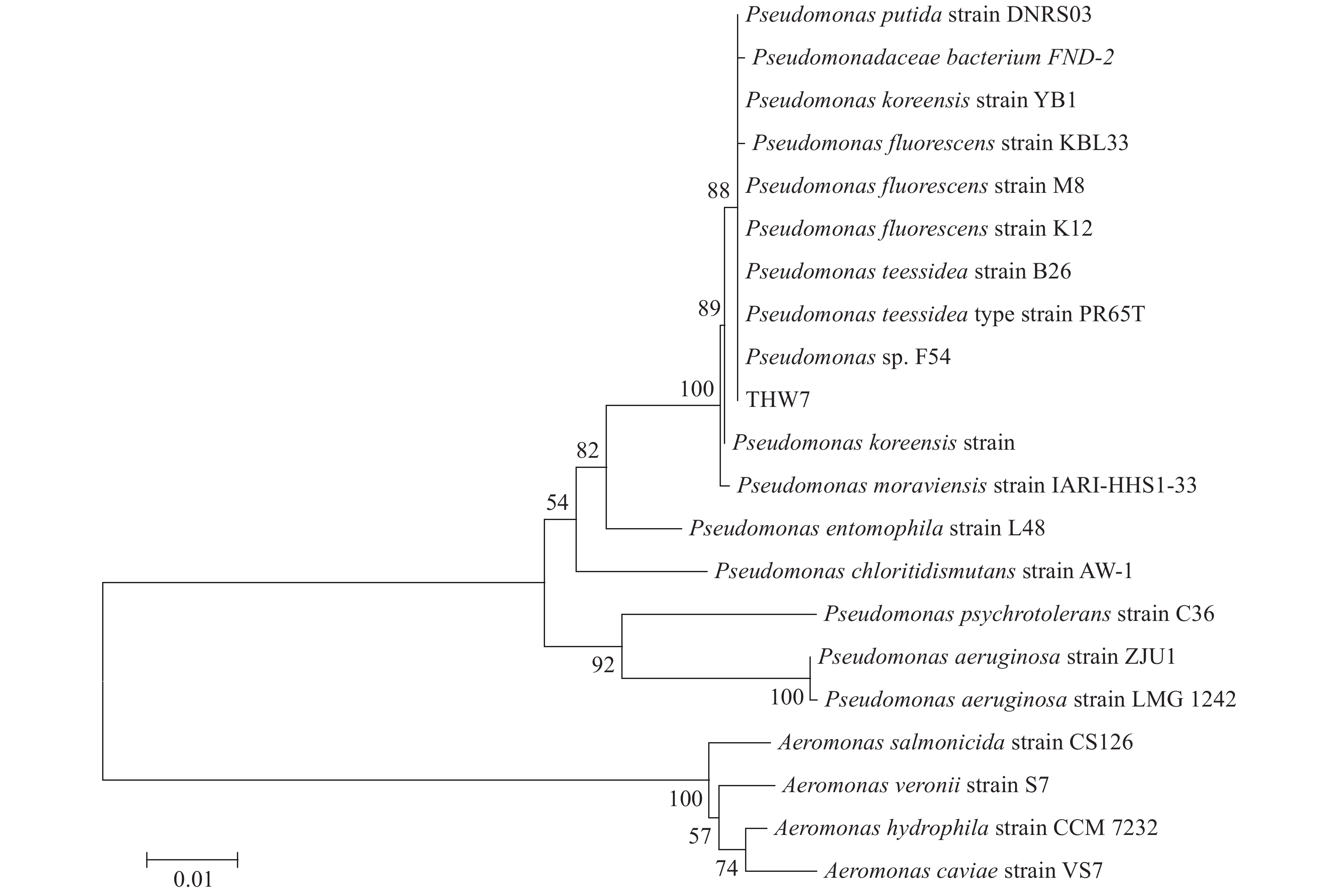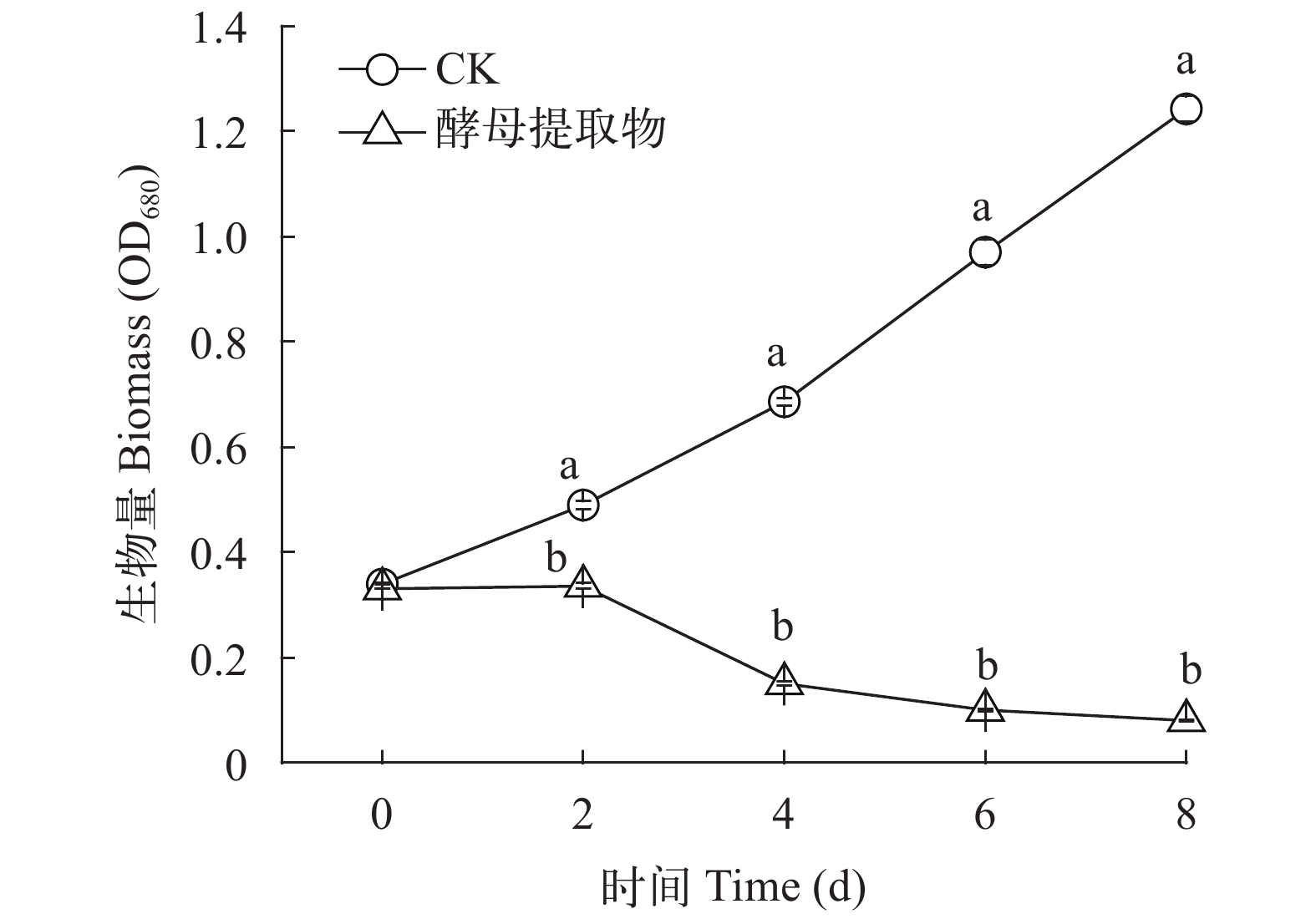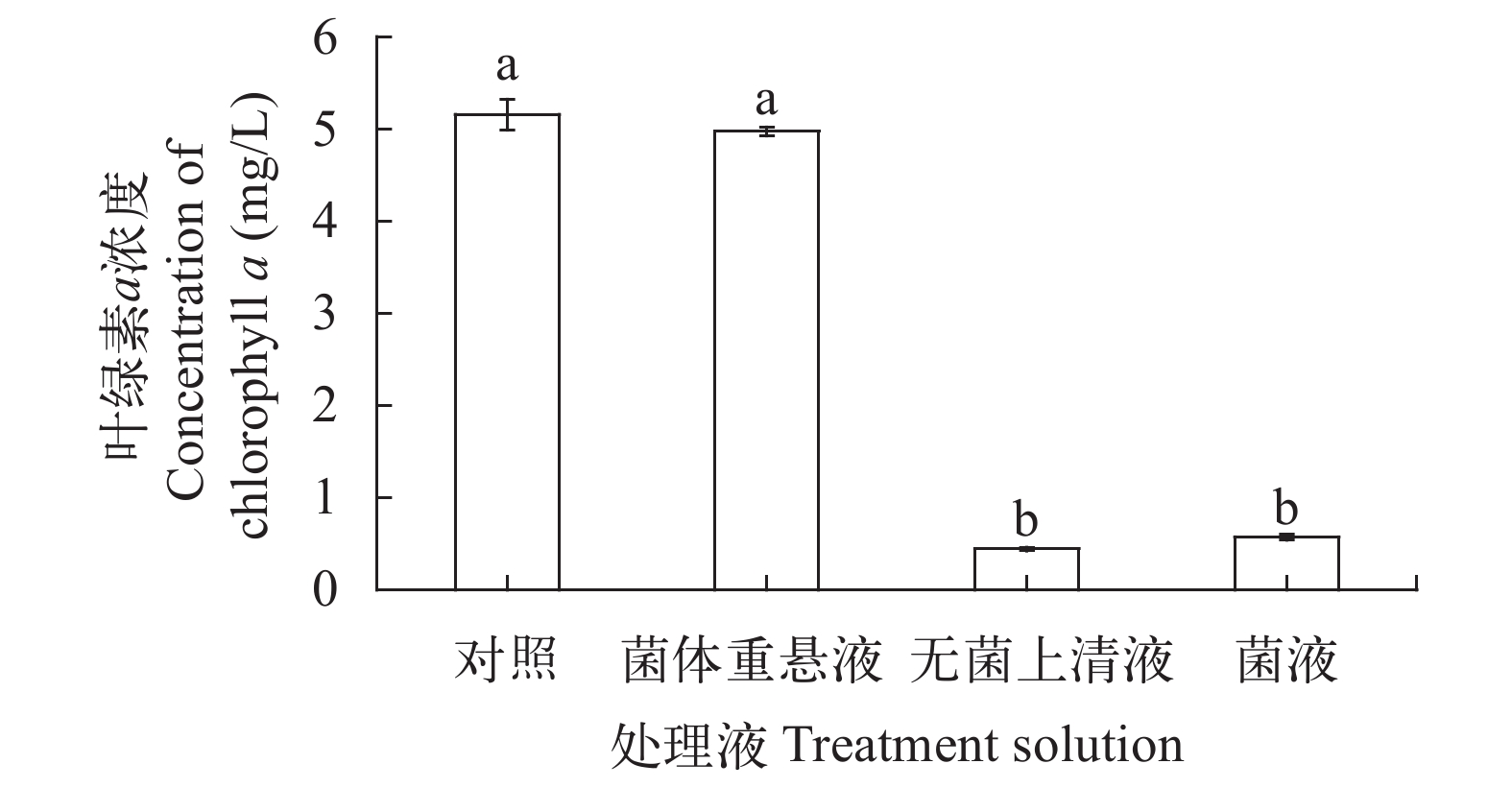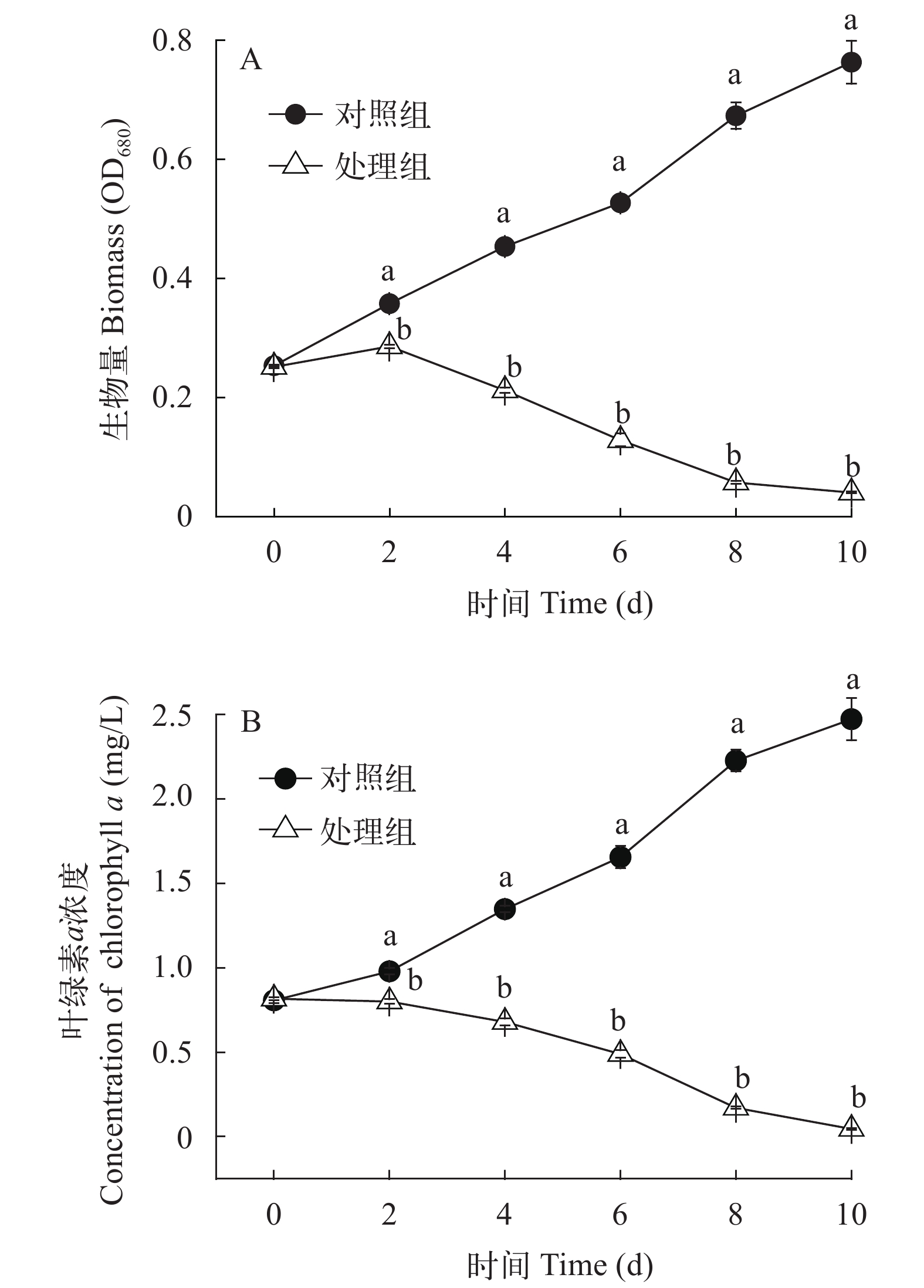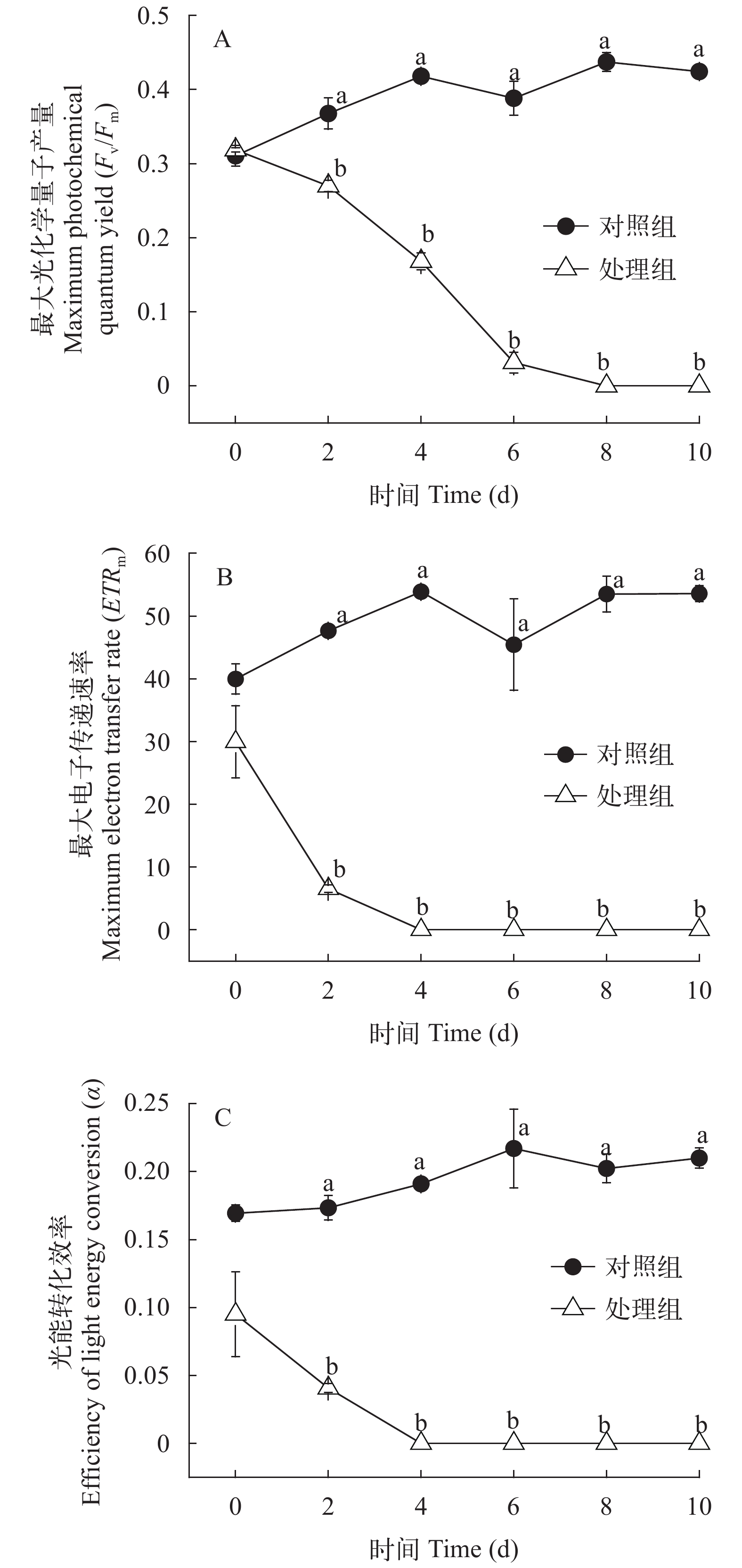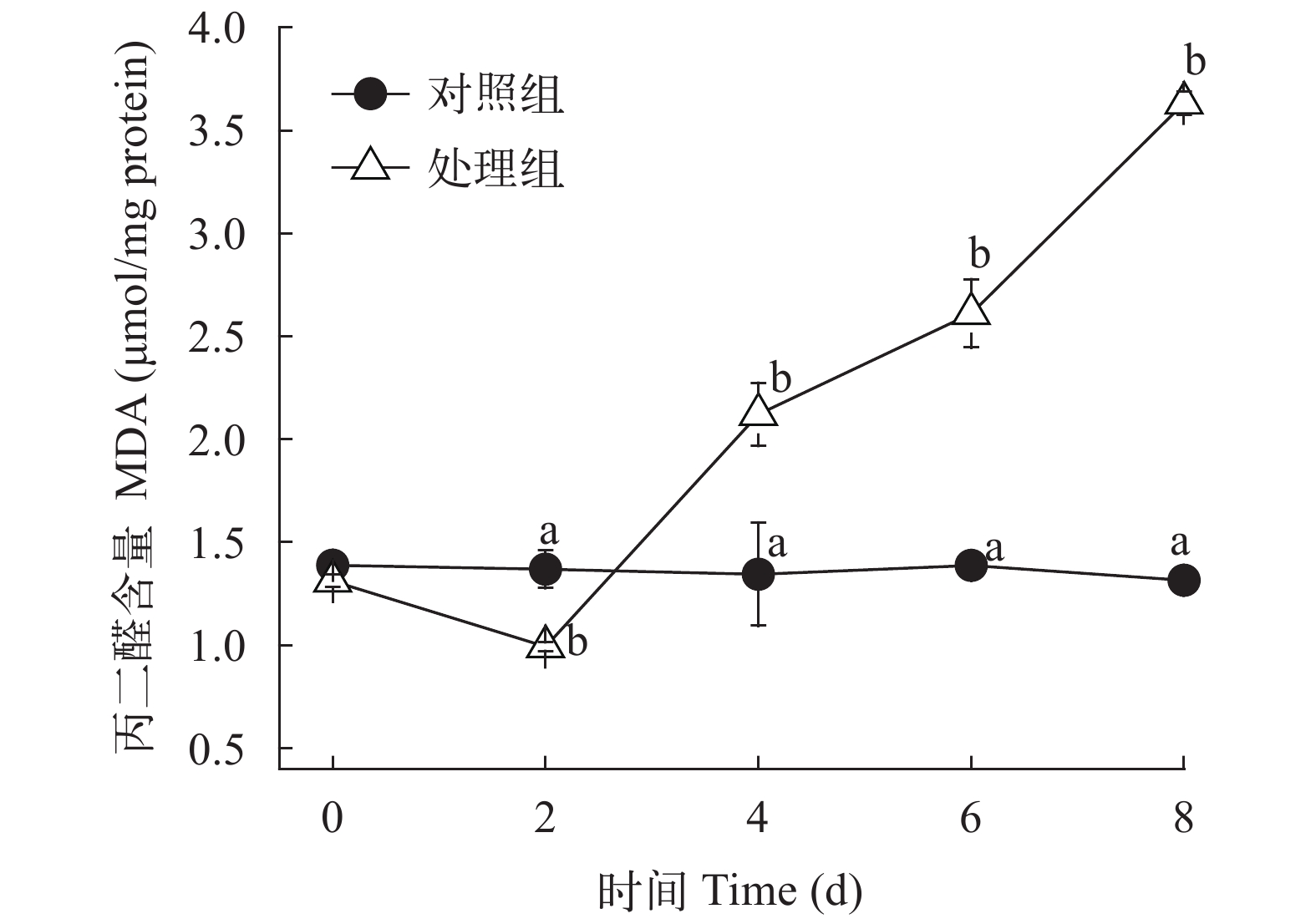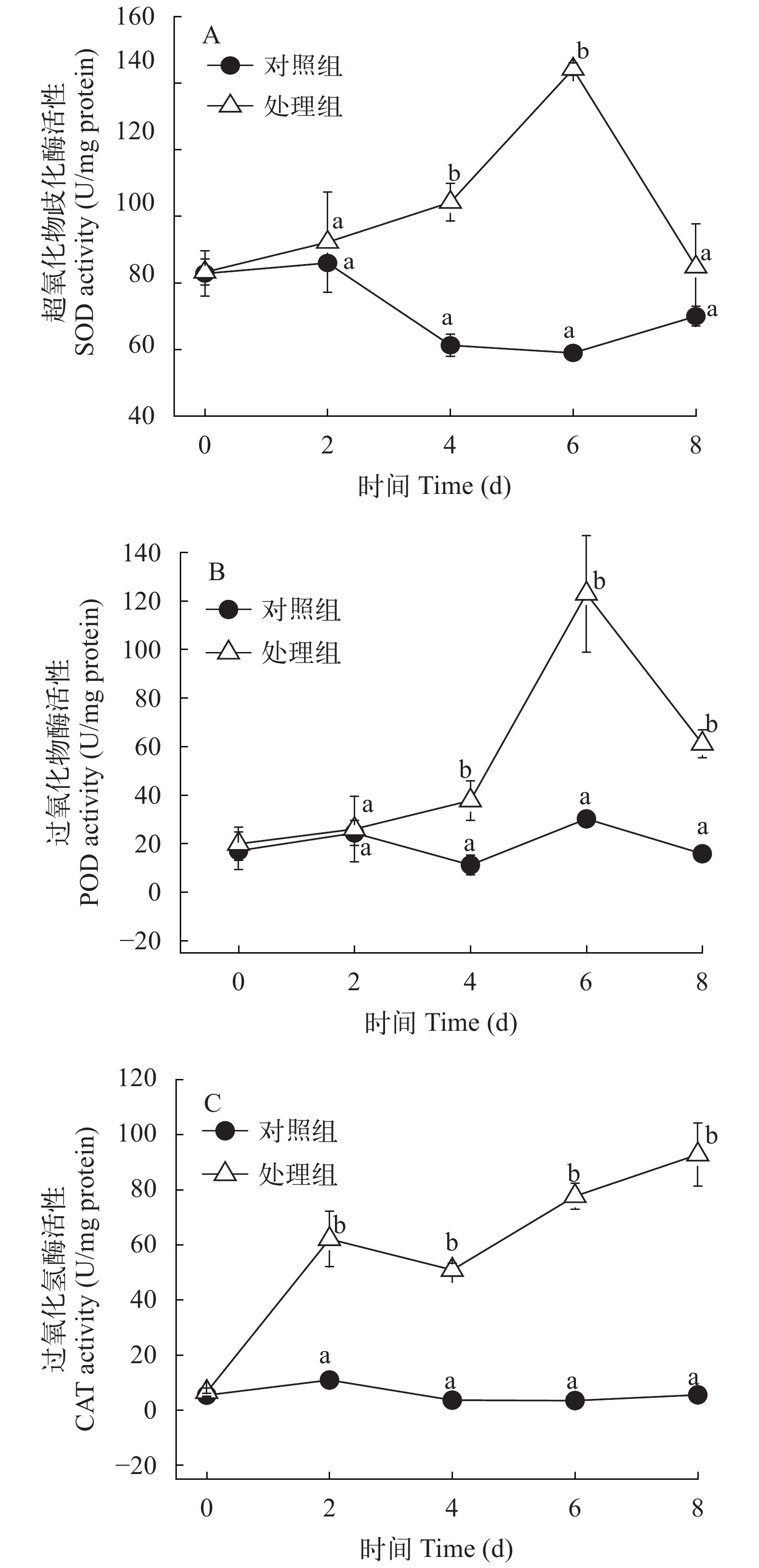SCREENING OF ALGAE-LYSING BACTERIA AND THE EFFECTS OF ALGAELYSING ACTIVE SUBSTANCES ON THE PHYSIOLOGICAL ACTIVITIES OF MICROCYSTIS AERUGINOSA
-
摘要: 从太湖水华水体中分离纯化细菌, 再将细菌的LB液体和固体斜面纯培养物分别收集后感染铜绿微囊藻(Microcystis aeruginosa)细胞, 从中筛选出7株具有溶藻活性的细菌, 并对其中一株溶藻细菌THW7的溶藻方式及溶藻活性物质对铜绿微囊藻生理活性的影响进行了初步研究。结果表明: 仅采用细菌的LB液体纯培养物进行溶藻细菌筛选会存在误筛或高估溶藻效率的风险, 而采用细菌的固体斜面纯培养物进行筛选则可避免以上风险; 溶藻细菌THW7通过分泌胞外活性物质的方式间接溶藻; 在THW7无菌滤液胁迫下, 铜绿微囊藻的生长受到显著抑制(P<0.01), 10d溶藻效率可达94.38%, 光合系统活性也显著降低(P<0.01), MDA含量积累, SOD、POD、CAT活性整体呈现先升高后降低的趋势且显著高于对照组(P<0.01)。推测菌株THW7分泌的溶藻活性物质可能作用于铜绿微囊藻细胞的光合系统Ⅱ, 阻碍电子传递, 抑制其光合作用过程, 并对藻细胞产生氧化损伤, 破坏藻细胞细胞膜的完整性, 从而实现溶藻作用。Abstract: Bacteria were isolated and purified from Taihu Lake, where algal blooms occur annually. We used LB liquid and solid slant pure culture solutions of bacteria to infect Microcystis aeruginosa cells, which resulted in the identification of seven strains of bacteria with algae-lysing activity. The method by which the algae-lysing bacterium THW7 lyses algae and the effects of its algae-lysing active substances on the physiological activities of Microcystis aeruginosa were preliminarily studied. The results showed that there was a risk of failed screening or overestimating the efficiency of algae-lysing bacteria when using only LB liquid pure culture solution to screen algae-lysing bacteria, and this risk could be avoided by using the solid slant pure culture solution of bacteria. The algae-lysing bacterium THW7 indirectly lysed algae by secreting extracellular active substances. When treated with the aseptic filtrate of THW7, the growth of Microcystis aeruginosa was significantly inhibited (P<0.01), and the algae-lysing efficiency reached 94.38% on the 10th day. Additionally, the activity of the photosynthetic system significantly decreased (P<0.01); the MDA content accumulated; and the activities of SOD, POD and CAT generally increased first and then decreased and were significantly higher in the treatment group than that in the control group (P<0.01). The algae-lysing active substances secreted by strain THW7 may act on photosynthetic system II of Microcystis aeruginosa cells, thus preventing electron transfer and inhibiting the photosynthetic process. These substances also induced oxidative damage in the algal cells and destroyed the integrity of the algal cell membrane to achieve the algae-lysing effect.
-
-
图 1 两株细菌不同培养物的溶藻效果
A. LB液体培养物; B. LB固体斜面培养物; 数据为平均数±标准差(n=3)且标注字母不同表示在同一天不同组间存在显著差异; 下同
Figure 1. Algae-lysing effects of different culture solution of two bacteria in LB liquid culture
A. LB liquid culture solution; B. LB solid slant culture solution. Data are presented as the means±standard deviations (n=3), and different letters indicate significant differences among treatments within a day. The same applies below
-
[1] Sigee D C, Glenn R, Andrews M J, et al. Biological control of cyanobacteria: principles and possibilities [J]. Hydrobiologia, 1999, (395): 161-172.
[2] 吴刚, 席宇. 溶藻细菌研究的最新进展 [J]. 环境科学研究, 2002, 15(5): 43-46. doi: 10.3321/j.issn:1001-6929.2002.05.011 Wu G, Xi Y. The latest development of research on algae-lysing bacteria [J]. Research of Environmental Sciences, 2002, 15(5): 43-46. doi: 10.3321/j.issn:1001-6929.2002.05.011
[3] Shi S, Tang D, Liu Y. Effects of an algicidal bacterium Pseudomonas mendocina on the growth and antioxidant system of Aphanizomenon flos-aquae [J]. Current Microbiology, 2009, 59(2): 107-112. doi: 10.1007/s00284-009-9404-0
[4] Su Z, Hua Y, Tang S, et al. Physiological responses of Microcystis aeruginosa against the algicidal bacterium Pseudomonas aeruginosa [J]. Ecotoxicology and Environmental Safety, 2016, (127): 214-221.
[5] Hou S, Shu W, Tan S, et al. Exploration of the antioxidant system and photosynthetic system of a marine algicidal Bacillus and its effect on four harmful algal bloom species [J]. Canadian Journal of Microbiology, 2016, 62(1): 49-59. doi: 10.1139/cjm-2015-0425
[6] 孔赟. 溶藻菌分离鉴定、溶藻特性及作用机理研究 [D]. 杭州: 浙江大学, 2013: 84-90 Kong Y. Research on the isolation, identification, antialgal characteristics and mechanism of antialgal bacterium [D]. Hangzhou: Zhejiang University, 2013: 84-90
[7] 刘晶, 潘伟斌, 秦玉洁, 等. 两株溶藻细菌的分离鉴定及其溶藻特性 [J]. 环境科学与技术, 2007, 30(2): 17-22. doi: 10.3969/j.issn.1003-6504.2007.02.007 Liu J, Pan W B, Qin Y J, et al. Isolation and identification of two algae-lysing bacteria and their lytic character [J]. Environmental Science and Technology, 2007, 30(2): 17-22. doi: 10.3969/j.issn.1003-6504.2007.02.007
[8] 晋利, 刘赵普, 赵耕毛, 等. 一株溶藻细菌对铜绿微囊藻生长的影响及其鉴定 [J]. 中国环境科学, 2010, 30(2): 222-227. Jin L, Liu Z P, Zhao G M, et al. Effect of an algae-lysing bacterium on the growth of Microcystis aeruginosa and its identification [J]. China Environmental Science, 2010, 30(2): 222-227.
[9] 王海玉, 赵芳, 彭谦, 等. 溶藻细菌W-04的筛选及溶藻效果初探 [J]. 中国农学通报, 2009, 25(20): 267-271. Wang H Y, Zhao F, Peng Q, et al. Isolation of an algae-constraining bacteria strain W-04 and its effects on the growth of M. aeruginosa Kütz [J]. Chinese Agricultural Science Bulletin, 2009, 25(20): 267-271.
[10] 张洪铭, 普连仙, 张胜花. 一株溶藻细菌的筛选及鉴定 [J]. 环境科学导刊, 2018, 37(2): 42-45. Zhang H M, Pu L X, Zhang S H. Isolation, screening and identification of an algae-lysing bacterium [J]. Environmental Science Survey, 2018, 37(2): 42-45.
[11] 裴海燕, 胡文容, 曲音波, 等. 一株溶藻细菌的分离鉴定及其溶藻特性 [J]. 环境科学学报, 2005, 25(6): 796-802. doi: 10.3321/j.issn:0253-2468.2005.06.015 Pei H Y, Hu W R, Qu Y B, et al. Isolation and identification of one algae-lysing bacteria and its lytic character [J]. Acta Scientiae Circumstantiae, 2005, 25(6): 796-802. doi: 10.3321/j.issn:0253-2468.2005.06.015
[12] Rippka R, Deruelles J, Waterbury J B, et al. Generic assignments, strain histories and properties of pure cultures of cyanobacteria [J]. Journal of General Microbiology, 1979, 111(1): 1-61.
[13] 于海燕, 周斌, 胡尊英, 等. 生物监测中叶绿素 a 浓度与藻类密度的关联性研究 [J]. 中国环境监测, 2009, 25(6): 40-43. doi: 10.3969/j.issn.1002-6002.2009.06.012 Yu H Y, Zhou B, Hu Z Y, et al. Study on correlation between chlorophyll a and algal density of biological monitoring [J]. Environmental Monitoring in China, 2009, 25(6): 40-43. doi: 10.3969/j.issn.1002-6002.2009.06.012
[14] Du Z, Bramlage W J. Modified thiobarbituric acid assay for measuring lipid oxidation in sugar-rich plant tissue extracts [J]. Journal of Agricultural and Food Chemistry, 1992, 40(9): 1566-1570. doi: 10.1021/jf00021a018
[15] Beauchamp C, Fridovich I. Superoxide dismutase: improved assays and an assay applicable to acrylamide gels [J]. Analytical Biochemistry, 1971, 44(1): 276-287. doi: 10.1016/0003-2697(71)90370-8
[16] Choo K S, Snoeijs P, Marianne P. Oxidative stress tolerance in the filamentous green algae Cladophora glomerata and Enteromorpha ahlneriana [J]. Journal of Experimental Marine Biology and Ecology, 2004, 298(1): 111-123. doi: 10.1016/j.jembe.2003.08.007
[17] 郑小平, 谢骏, 刘波, 等. 一株溶藻细菌的分离鉴定及其溶藻效应初探 [J]. 淮海工学院学报 (自然科学版), 2005, 14(1): 69-71. Zheng X P, Xie J, Liu B, et al. Separation and lytic study of one algae-lysing bacteria [J]. Journal of Huaihai Institute of Technology (
Natural Science Edition ) , 2005, 14(1): 69-71. [18] 吕伟英. 溶藻细菌筛选方法的优化及W5菌株溶藻特性的研究 [D]. 武汉: 华中师范大学, 2006: 13-20 Lv W Y. Study on optimization of screening methods for algae-lysing bacteria and algae-lysing characteristics of strain W5 [D]. Wuhan: Central China Normal University, 2006: 13-20
[19] Guo X, Liu X, Wu L, et al. The algicidal activity of Aeromonas sp. strain GLY-2107 against bloom-forming Microcystis aeruginosa is regulated by N-acyl homoserine lactone-mediated quorum sensing [J]. Environmental Microbiology, 2016, 18(11): 3867-3883. doi: 10.1111/1462-2920.13346
[20] Lee S, Kato J, Takiguchi N, et al. Involvement of an extracellular protease in algicidal activity of the marine bacterium Pseudoalteromonas sp. strain A28 [J]. Applied and Environmental Microbiology, 2000, 66(10): 4334-4339. doi: 10.1128/AEM.66.10.4334-4339.2000
[21] Imamura N, Motoike I, Noda M, et al. Argimicin A, a novel anti-cyanobacterial compound produced by an algae-lysing bacterium [J]. The Journal of Antibiotics, 2000, 53(11): 1317-1319. doi: 10.7164/antibiotics.53.1317
[22] Yoshikawa K, Adachi K, Nishijima M, et al. β-cyanoalanine production by marine bacteria on cyanide-free medium and its specific inhibitory activity, toward cyanobacteria [J]. Applied and Environmental Microbiology, 2000, 66(2): 718-722. doi: 10.1128/AEM.66.2.718-722.2000
[23] Kawano Y, Nagawa Y. Production of thiotropocin by a marine bacterium, Caulobacter sp. and its antimicroalgal activities [J]. Journal of Marine Biotechnology, 1997, 5(4): 225-229.
[24] Dakhama A, Delanoue J, Lavoie M C. Isolation and identification of antialgal substances produced by Pseudomonas aeruginosa [J]. Journal of Applied Phycology, 1993, 5(3): 297-306. doi: 10.1007/BF02186232
[25] Kodani S, Imoto A, Mitsutani A, et al. Isolation and identification of the antialgal compound, harmane (1-methyl-β-carboline), produced by the algicidal bacterium, Pseudomonas sp. K44-1 [J]. Journal of Applied Phycology, 2002, 14(2): 109-114. doi: 10.1023/A:1019533414018
[26] Schreiber U, Hormann H, Neubauer C, et al. Assessment of photosystem Ⅱ photochemical quantum yield by chlorophyll fluorescence quenching analysis [J]. Australian Journal of Plant Physiology, 1995, 22(2): 209-220.
[27] Hong Y, Hu H Y, Xie X, et al. Responses of enzymatic antioxidants and non-enzymatic antioxidants in the cyanobacterium Microcystis aeruginosa to the allelochemical ethyl 2-methyl acetoacetate (EMA) isolated from reed (Phragmites communis) [J]. Journal of Plant Physiology, 2008, 165(12): 1264-1273. doi: 10.1016/j.jplph.2007.10.007
[28] 施军琼, 杨燕君, 董聪聪, 等. 棕鞭藻及其培养滤液对铜绿微囊藻生长及生理特性的影响 [J]. 水生生物学报, 2019, 43(1): 217-222. Shi J Q, Yang Y J, Dong C C, et al. Effects of Ochromonas sp. culture media filtrate on the growth and physiological traits of Microcystis aeruginosa [J]. Acta Hydrobiologica Sinica, 2019, 43(1): 217-222.



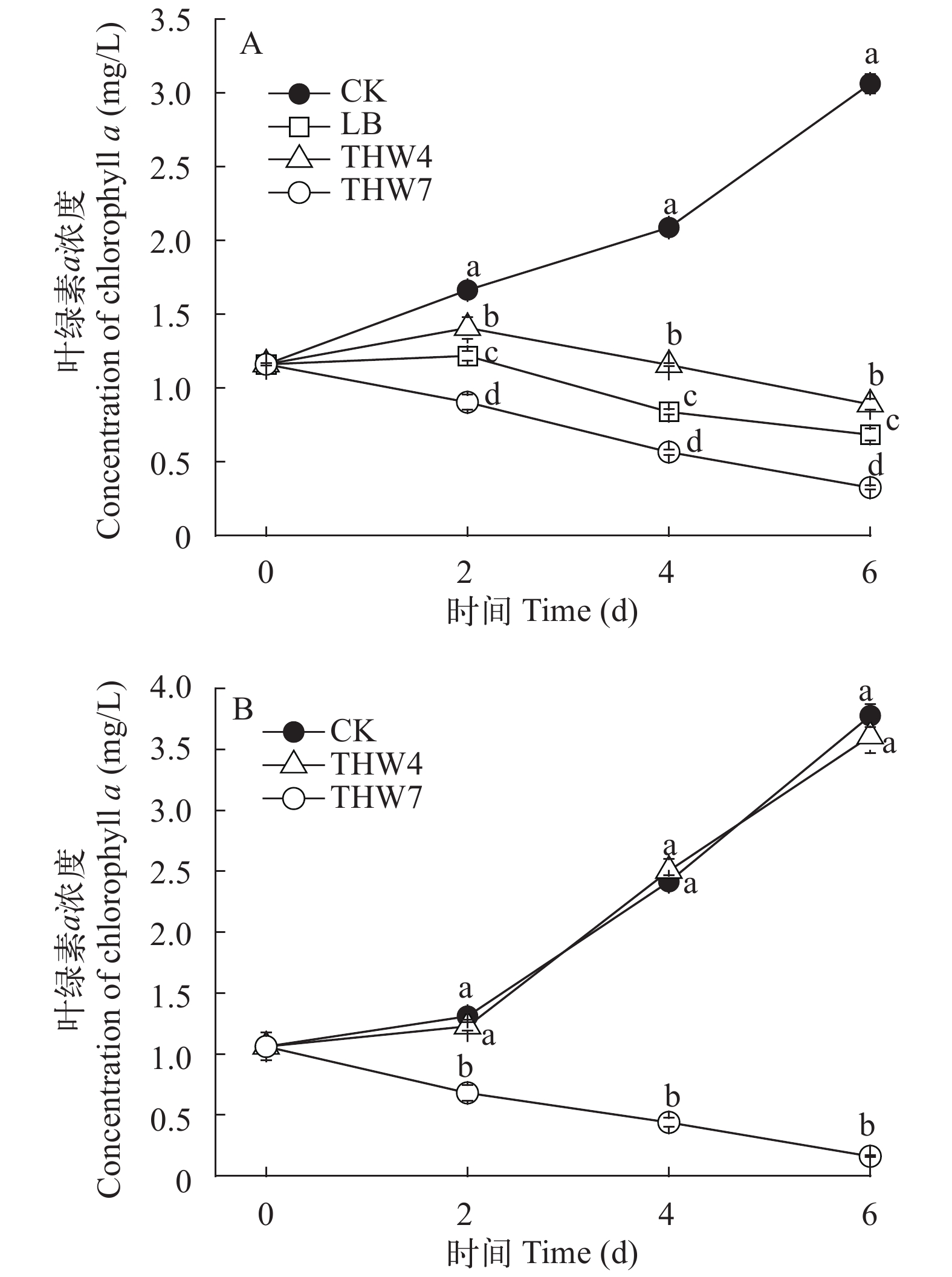
 下载:
下载:
